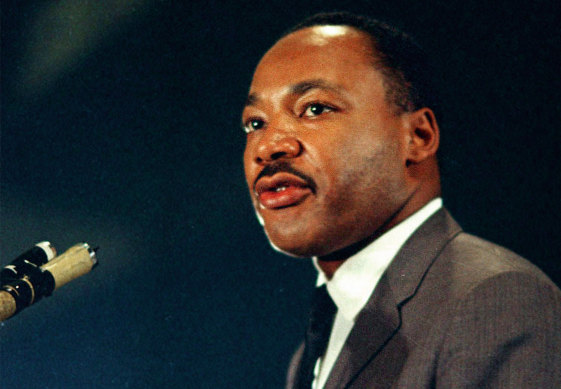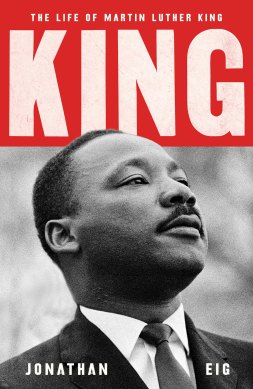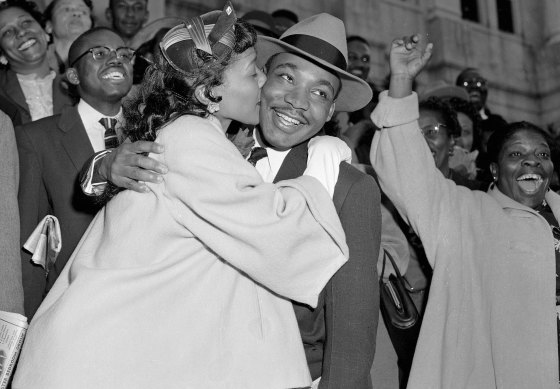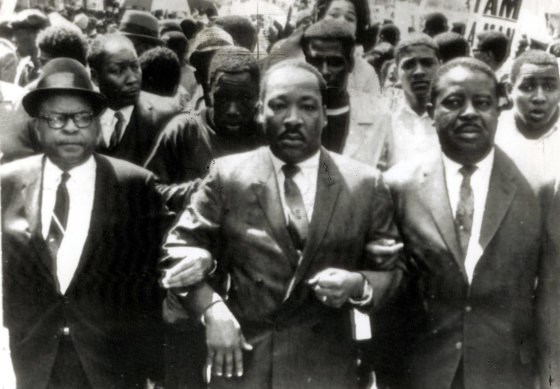By Shane White
BIOGRAPHY
King: A Life
Jonathan Eig
Simon & Schuster, $49.99
In 2015, stand-up comic Dick Gregory commented that when his friend Martin Luther King jnr “was shot, he was the most hated man on the planet … now he’s the most beloved.” Memorialisation, Jonathan Eig, author of King: A Life, explains, has “defanged” King.
It is not as though historians and biographers have ignored King. The nearly 3000 pages of Taylor Branch’s magisterial America in the King Years trilogy – Parting the Waters (1988); Pillar of Fire (1998); and At Canaan’s Edge (2006) – remain a riveting read. The previous biography, David Garrow’s Bearing the Cross (1986), was also very good. It won the Pulitzer Prize. That was near four decades ago.

Jonathan Eig’s new life of Martin Luther King jnr says in hallowing him, he has been hollowed.Credit: AP
But now new sources are available. Eig has ferreted them out assiduously. These include a trove of papers collected by King’s unofficial archivist, tapes of interviews Coretta King recorded soon after her husband’s assassination and Eig’s interviews with civil rights activists. Above all, in the past few years the Federal Bureau of Investigation has released thousands of pages of secret files, the record of its harassment of the Black activist.
As well, and as Dick Gregory understood, times have changed. Since 1983, the third Monday of each January has been Martin Luther King Jr Day, a federal holiday in the United States. Nearly a thousand cities and towns have named streets in King’s honour. More than 100 public schools bear his name.

Credit:
There is now a 30-foot tall King Memorial statue not far from the Washington Mall’s shrines to Abraham Lincoln and Thomas Jefferson. King has entered the American Pantheon, become a founding father. But Eig suggests that “in hallowing King we have hollowed him”.
The memorialised King lacks the edginess he had in life. There is ample room for a new biography to recover the real man from hagiography.
Born in 1929, King was raised on “sweet Auburn”, Atlanta’s vibrant Black avenue. His father, “Daddy King”, was the preacher at Ebenezer Baptist Church. Although the Depression years were particularly hard for African Americans, the young King had a relatively comfortable upbringing.
One of the highlights of King’s childhood occurred in 1939 when Gone with the Wind had its gala premiere in Atlanta. Contrary to the wishes of many African Americans, Daddy King arranged for Ebenezer’s choir to perform at the segregated celebration of antebellum southern life. Front and centre was a 10-year-old King, dressed as a slave and singing along. The mind boggles.
Without quite putting him on the psychiatrist’s couch, Eig analyses King’s childhood, giving a nuanced account of his character development. Daddy King was a domineering figure who thrashed his children. For at least one close friend these beatings “brutalised” King, making him “a much more fearful man than he appeared”.
Confronting racists was never a problem, but King’s avoidance at any cost of conflict with allies hindered the civil rights movement. In particular, he became indecisive when confronted with disputes over strategy with pioneer Black activists such as Roy Wilkins or older members of his own organisation. This even flowed into his personal life as he continually sidestepped discord with his wife.

Martin Luther King jnr and his wife, Coretta Scott King, pictured in Montgomery, Alabama in 1956.Credit: AP
For all the self-assurance King derived from his privileged upbringing, it also left him with a lifelong guilt that he often raised with his wife and friends. Eig believes this guilt impelled the often troubled African American to become a reformer.
Educated at Crozer Theological College and Boston University, Dr King was called to Dexter Avenue Baptist Church in Montgomery, Alabama. Likely, he was destined for an academic position somewhere or other, but in 1955 the Montgomery bus boycott intervened. Somewhat reluctantly, King took over.
Although he started out as a spokesman, King transformed into a leader. For the next dozen years until his assassination in 1968, he was the face of the civil rights movement. His charisma and above all his enthralling oratory galvanised African Americans. King and his compatriots, notably Ralph Abernathy, set out to end racial discrimination and to redeem the soul of America.
King estimated that in 1957 he travelled 780,000 miles and delivered 208 speeches. The mileage is exaggerated, but the claim hints at the punishing schedule of airports and cheap motels that became his life. His wife commented: “I hardly saw him.“
Eig re-emphasises the radicalness of King’s philosophy. “We’ve mistaken King’s nonviolence for passivity.” Peaceful protest fomented a revolution in southern life. In the 1960s he broadened his demands, talking about economic discrimination, raising the issue of reparations for slavery and segregation. Above all, he became one of the first and most prominent figures to deplore the war in Vietnam.
Eig takes seriously Coretta King’s role. She saw herself as his partner in civil rights work and opposition to the war, but King had traditional ideas about the family. As he told her “I am called [by God], and you aren’t.” King, like his father, was a flagrant womaniser. This was known by many, probably including Coretta, in large part because director of the FBI, J. Edgar Hoover, ensured this was the case. She remained the epitome of dignity.
Perhaps the most shocking revelation in the book is the detail of the FBI hounding of King. Eig’s account makes clear that it was Hoover’s personal vendetta against the man he considered, with no evidence at all, to be a communist threat to his country. Agents behaved outrageously and illegally, threatening to expose his infidelities, even suggesting King should kill himself.

Martin Luther King jnr (centre) locks arms with Rev. Ralph Abernathy, right, and Rev. Ralph Jackson, left, during a civil rights march in Memphis in March 1968.Credit:
Eig’s King is a flawed man, certainly no saint. But an account of King’s shortcomings makes his courage and moral vision all the more exceptional. King: A Life is the new definitive biography of Martin Luther King Jr.
Shane White’s Prince of Darkness: The Untold Story of Jeremiah G. Hamilton, Wall Street’s First Black Millionaire is published by Picador.
The Booklist is a weekly newsletter for book lovers from books editor Jason Steger. Get it delivered every Friday.